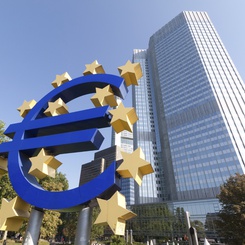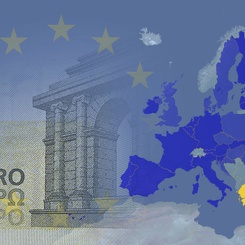Radu Vranceanu, Professor and Head of the Department of Economics at ESSEC Business School, looks into the long-lasting impact of the world’s last financial crisis on the Eurozone and assesses the strategies put in place to recover from it
Still shocking and shaking
The shock waves of the Global Financial Crisis of 2007-2009 are still shaking the word economy ten years after the initial impact. In particular, the response of the Eurozone countries is both worrying and revealing of the structural weaknesses of the region.
Contrary to the US, Eurozone governments had to abruptly reverse their fiscal stimulus in 2010 when a new crisis, related to their sovereign debts, emerged. Following a pattern so far observed mostly in the developing countries, investors’ refusal to roll over public debt prompted Greece to default in 2012, with governments in four Euro economies (Portugal, Spain, Ireland, Cyprus) having to be bailed out by an EU-backed fund and the IMF. Tensions on the sustainability of Italian and Spanish Public debt in 2012 ultimately prompted the European Central Bank (ECB) to pass the Outright Monetary Transaction scheme (OMT) that many observers have interpreted as a renouncement of its no-bail out commitment.
Put a little trust in the cement
The financial fabric of the Eurozone economies has not yet fully recovered from these two major crises. If prudential indicators in many countries are back to pre-crisis levels and even improved, the most important asset has not fully recovered. This key asset is trust: trust in financial intermediaries, trust in financial experts, and trust in people engaged in a lender/borrower relationship. As the economist Kenneth Arrow stated years ago (The Limits of Organization, 1974), trust is a key ingredient for the good functioning of any market economy, as it allows economizing on transaction costs. In the financial markets, lack of trust in institutions can lead to self-fulfilling panics such as bank runs or episodes of massive capital flight.
As a consequence of this generalized state of mistrust, any minor shock can undergo major amplification. Indeed, such an example of mistrust-based panic can be seen in the sharp fall in the stock of Eurozone banks triggered by the surprise fall in oil prices in 2015, and which challenged the quality of loans and other investments in oil-backed projects and firms. So far, the creation in 2014 of the Single Supervisory Mechanism and Single Resolution Mechanism do not seem capable of restoring this much-needed trust in the Eurozone banking sector.
How unconventionally constructive can we be?
The only player that seemed able to overcome all these difficulties was the ECB. As already mentioned, the ECB curbed the sovereign debt crisis in 2012 when Mario Draghi introduced the OMT. Later on, it seemed able to provide the much-needed additional stimulus to the Eurozone economies when governments had to adopt tighter public deficit targets as imposed by the adoption of the Fiscal Compact, a renewed version of the Stability and Growth Pact. Indeed, after exhausting the conventional weapon – reducing to zero short-term interest rates – the ECB moved energetically toward “unconventional measures” such as bond purchases and carrying out three waves of long-term refinancing operations. As a consequence of this discretionary control of the monetary base, the balance sheet of the ECB has risen from €2,000bn in 2010 to €3,500bn in recent months.
However, after four years of experimentation with “unconventional” monetary measures, the outcome falls below expectations. If the risk of deflation seems to be pushed away, the inflation rate is still very small, and well below the 2% per year medium run target. Furthermore, it is not obvious whether the price rise in the last few months is due to the direct action of the ECB or merely to rising energy prices and resulting expectations of inflation.
Liquidity: rising damp and dangerously?
Long term refinancing operations – through which the ECB is lending money at zero or negative interest rate to banks over three to four years – seemed to have contributed to raising credit in the Eurozone private sector. At 1.7% annual growth in August, loans to non-financial institutions are now increasing at a normal rate.
Since March 2015, the ECB has been buying 60bn Euro bonds a month, rising of late to 80bn a month – a policy referred to as Quantitative Easing (QE). It is likely that this policy has contributed to pushing down long-term interest rates. Yet, contrary to expectations, the fall in the long-term interest rate has had a modest impact on private investment. Inversely, it has eroded the profit margins of Euro banks, with dramatic consequences on the most fragile of them. Lower bank profitability prompts banks to avoid riskier deals, and may have a negative impact on the supply of loans. Since the Eurozone relies on banks much more than the US to finance the economy, ultimately the QE can have an adverse effect on growth and investment in real projects.
If the increase in the monetary base orchestrated by the ECB has not lifted output and prices in a significant way, what has it achieved? Several experts claim that this excess of liquidity is actually fuelling a rise in asset prices. This assumption is backed by evidence on the relatively strong performance of Eurozone stock indexes.
As an example, since the implementation of the QE, the main stock market index in France (CAC 40) has increased by 40%. With an average Price/Earnings Ratio (PER) as high as 21 (as high as the PER of the S&P 500), these large firms appear to be overvalued. Housing prices are on the rise again. This only contrasts with the high unemployment rate in France which lies at 10%, and the mediocre growth of 1.3% in the third quarter of 2016 compared to the same quarter of the previous year.
Next steps
In December, the ECB will probably have to weigh the risk of nurturing an asset bubble against the risk of reducing monetary stimulus and “kill” the already weak growth in the Euro area. If the ECB chooses to stop the bond purchase program – what is usually referred to as “tapering” – this would lead to an increase in long-term interest rates. And higher interest rates would come with a higher fiscal burden for governments, in particular those with shorter debt maturities. On the other hand, this return to normality could entail a positive effect on investment, as banks’ profitability would improve and they would agree to take more risks.
The last decade has shown that the Eurozone is poisoned by a form of “Japanization” rampant in southern Europe, and that only a comprehensive structural reform can help fight it in the long run. In recent analyses, the OECD pointed out that excessive employment protection legislation and reduced competition in the goods markets are responsible for the poor performance of many European economies (OECD Employment Outlook, 2016). Yet, in the short run, structural reforms come with costs. All this might increase political tensions – in a world where extremisms of all sides proliferate.









